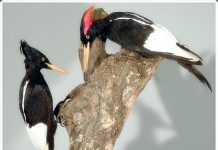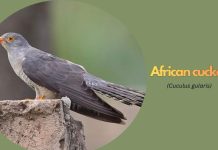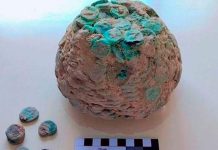A Spectacled Monarch (Monarcha trivirgatus) lives alone or in pairs in the middle and lower layers of the rainforest, beneath its sheltering canopy. They forage mainly within five meters of the ground, occasionally reaching the top of trees, but rarely the ground itself. Birds are commonly seen perching sideways on tree trunks to pick under loose bark, then flitting to horizontal vines to grab insects before returning to tree trunks. Insects are rarely caught on the wing by them.
They often flutter and tumble among foliage as they feed, making their rapid movements jerky; in northern Queensland, they sometimes tumble and skate along the leaves of the fan palms Licuala, likely disrupting insects like flies and moths, which they capture.

They rarely hawk out to capture insects on the wing, despite this. Besides ants, cockroaches, flying termites, spiders, and snails, they also eat leaves and lower vine tangles. Spectacled Monarchs are nearly always present with mixed foraging flocks of birds in the rainforest.
There are two races in Australia, and their status differs. An endemic species of the Cape York Peninsula and Mcillwraith Range, with pure white lower breast, flanks, and belly, is quite sedentary.
The other, whose russet cascades over the flanks and belly, breeds from Cooktown south to New South Wales and is partially or wholly migratory. The population south of Maryborough, Queensland, leaves in the winter when southern migrants appear on Cape York Peninsula and southern New Guinea. The majority of migration across the Torres Strait occurs at night. It is also known as Black-fronted Flycatcher. The Spectacled Monarch is about 150-160 mm in length.
There is no difference between the sexes in terms of appearance; the female is slightly duller. The upper parts are dark blue-grey in color. The forehead to ear coverts is black. The tail is dark slate, with three outer feathers tipped with white. The wing covers are dark blue-grey, and the wing quills are brown-grey with grey edges. Depending on the race, the chin, upper throat, sides of the neck, and breast are black; the lower throat, sides of the neck, and undertail are orange-rufous. The eyes are dark brown in color. Pale blue-grey is the color of the bill. Dark steel-grey is the color of the feet. Immature underparts are duller than in adults; black face pattern grey; buff-white marking in front of and below eye over lores. Throat and forehead feathers have white tips.
Spectacled Monarchs call with a buzzing gzzhhh, repeated several times; they also use an up-slurring nasal rattle, zweee-zweee-zweee. The song of the Spectacled Monarch, however, is a short squeaky warble.
Breeding and nesting take place from October to February. An upright tree branch or vine tangle is a good place to build a deep cup-shaped or conical nest, which is made up of interlaced bark strips and rootlets, covered with green moss, cobwebs, and spider egg cases.
There are two eggs laid by the Spectacled Monarch, which are dull or glossy cream to pale pink, freckled with red-brown, and underlying dull purple. The Monarch is named after its large black eye patches. At its larger end, the bird nests in an upright fork or vine tangle that is long-oval and about 21 x 16 mm in size.
Spectacled Monarchs are found along coastal eastern Australia, mainly in rainforests, mangroves, and their fringes, between Cape York Peninsula and northeastern New South Wales. Also found in Timor, Moluccas, New Guinea, and nearby islands. Approximately seven races exist in the world; however, there are only two in Australia.
Related Reading: Black-winged Monarch (Monarcha frater)







